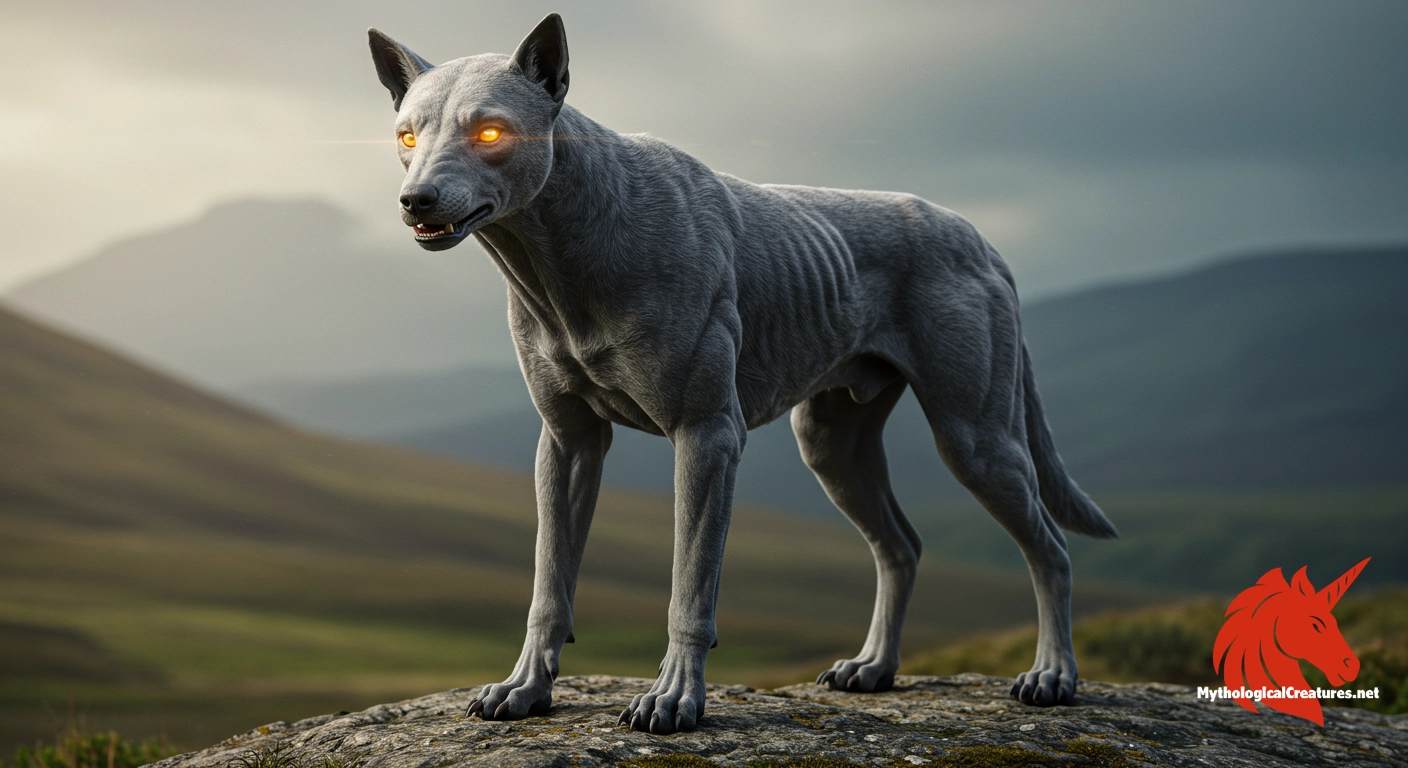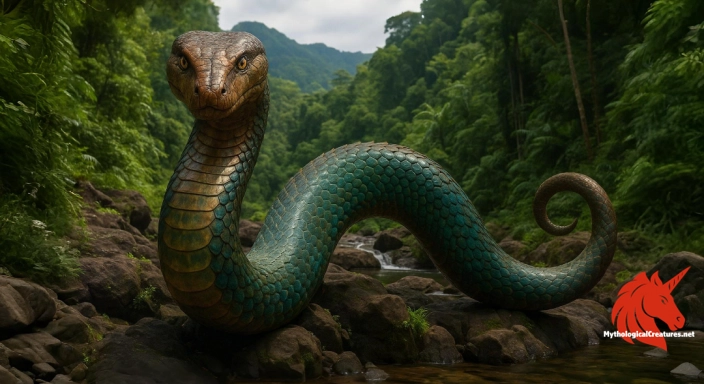Failinis: Failinis is a mythological hound from Irish literature, originally belonging to Lugh Lámhfhada of the Tuatha Dé Danann and later associated with the Fenian Cycle.

Failinis
Failinis - Failinis is integral to narratives involving Lugh and the reparations from the sons of Tuireann, marking the intersection of divine retribution and cultural migration in Irish myth.
Origins & First Encounters
Failinis emerges in the rich tapestry of Irish myth as a creature of both supernatural loyalty and intricate reparation. Born into the legendary narratives of the Tuatha Dé Danann, this mythic hound is intimately connected with Lugh Lâmhfhada, whose heroic exploits tie it to the divine order. Its origins trace back to ancient reparative rituals, where it was one of the eric items exacted from the sons of Tuireann, symbolising the intricate balance of compromise and recompense. Early accounts hint at its beginnings as a hound-whelp nurtured in the creative forges of Iruaith, the hall of kings and smiths. The creature’s tale is interwoven with diverse strands of mythology that span the mystical and the heroic, demonstrating the broad reach of its legend. Its first attestation in mythic cycles reflects a time when divine intervention and mortal sagas merged seamlessly. Beyond mere possession, Failinis represents the bond between celestial beings and the mortal realm, an emblem of loyalty even amidst legendary conflict. The myth encapsulates themes of service, sacrifice, and the enduring power of restitution in a world ruled by fate and magic. Each narrative cycle that mentions Failinis adds layers of interpretation to its identity, from a prized canine companion to a symbol of cosmic justice. The enduring appeal of its story ensures that Failinis remains a significant figure in the lore of ancient Ireland.
Source Texts & Tale Variants
The primary chronicles of Failinis start with its detailed mention in the mythological cycle of Irish literature, where the hound is spoken of with reverence. Ancient Irish texts record this creature as a treasured possession of Lugh Lâmhfhada, framing it as an essential element in the complex balance of reparation for misdeeds. Various manuscripts occasionally attribute the origin of Failinis to Iruaith, the storied realm of kings and skilled craftsmen, further adding to its mystique. In some traditions, the dog’s early life as a hound-whelp is recounted with particular solemnity, evoking an aura of innocence and destined greatness. Later narratives shift its ownership to a foreign threesome from Iruaith, highlighting its journey across cultural landscapes. Oral traditions and medieval storytellers provide colourful embellishments that vary in detail but consistently echo its status as an otherworldly instrument of fate. The story finds additional contours when it appears alongside the Fíanna led by Fionn mac Cumhaill in the Fenian cycle, blending heroic adventure with mystical reparation. Diverse accounts further note variations in names, with forms such as Fer Mac adding complexity to the textual tradition. Even when sources diverge in style and emphasis, they collectively enrich the mythos surrounding the noble hound. The interplay of these sources offers a multifaceted glimpse into a creature that transcends simple description.
Form & Powers
Descriptions of Failinis, though fragmentary, evoke the image of a hound suffused with both grace and otherworldly strength. The creature is imagined as possessing a sleek and muscular frame, a testament to its divine origins and heroic service. Its coat is often depicted in subtle, earthy tones that seem to capture the shifting light of the mystical landscapes from which it hails. Observers in legend reputedly noted a distinctive gleam in its eyes—a quiet luminescence that hints at inner wisdom and magical purpose. Artistic renditions lavish attention on the creature’s imposing yet agile stature, suggesting that every movement is as deliberate as it is spirited. There are suggestions of unusual markings along its flank, perhaps even hints of ancient runic designs that allude to its enchanted nature. Some accounts portray Failinis as large and noble, almost bordering on the majestic, while others recount a sleek and swift appearance apt for elusive heroics. Its ears, sharply attuned to the echoes of battle and ceremony, and a gaze that balances loyalty with a penetrating insight, elevate it beyond the status of an ordinary dog. This physical portrayal, though largely inferred from mythic symbolism, enriches the narrative tradition with vivid and memorable imagery. Through successive renditions in art and literature, the hound’s physical form continues to inspire and captivate the collective imagination.
Regional Faces
The story of Failinis adjusts and adapts as it travels across the varied regions of Ireland and intertwines with local mythic traditions. In some parts of the country, regional accounts underscore its role as the divine companion of Lugh Lâmhfhada and its symbolic connection to the mystique of the Tuatha Dé Danann. Other local traditions, particularly those in the west, embed the hound within broader community legends, adapting its narrative to the cultural nuances of the area. The influence of Iruaith in its origin story is more pronounced in some regional retellings, where the mythical land is depicted as a centre of artifice and power. Folk narratives sometimes incorporate the hound into festivals and rites, reflecting its significance as an emblem of reparation and cosmic balance. Variations in its portrayal—ranging from a majestic guardian to a nimble, spirited guide—demonstrate the flexibility of its myth across different cultural contexts. In areas with strong ties to the Fenian cycle, the creature’s encounter with the Fíanna further enriches its local resonance. The regional adaptations often enhance specific qualities, aligning the hound’s characteristics with local ideals of loyalty and justice. Through this diverse retelling, Failinis remains a unifying figure that adapts to the evolving spiritual and social landscapes of Ireland. The regional diversity in its portrayal underscores the dynamic nature of myth, where local customs and traditions recalibrate a shared narrative for new audiences.
Cultural Parallels
Failinis occupies a unique position among mythic canines, inviting comparison with other storied hounds in world mythology. Its role as both a divine companion and a symbol of reparation sets it apart from more fearsome or underworldly dogs found in other cultural pantheons. Unlike other legendary hounds that might guard the gates of the afterlife or emphasise ferocity, Failinis embodies a balance of gentle loyalty and utilitarian duty. Similar to the nuanced roles in Celtic lore, it reflects the intertwined fate of humans and the supernatural, much like renowned figures in Norse or Greek traditions. The transformation from a humble hound-whelp to a revered companion resonates with motifs seen in other mythic traditions where animals are elevated by their connections with divine heroes. This evolution highlights a shared archetype across cultures, where the supernatural animal both consoles and chastises, serving as an intermediary between realms. The narrative tension between its origins in Iruaith and its later appearances across the heroic Fenian saga mirrors comparable stories in other mythologies that stress the fluidity of mythic identity. Inter-cultural dialogues often celebrate such creatures as they symbolise dynamic forces that transcend simple categorizations. The exploration of Failinis alongside its counterparts deepens the understanding of how different societies attribute moral and magical significance to animal figures. Ultimately, the myth of Failinis contributes to a broader conversation about the enduring power of archetypal symbolism in myth worldwide.
Legacy & Modern Evolution
Over the centuries, the legend of Failinis has woven itself steadily into the fabric of Irish cultural and literary identity. The mythic hound, with its deep roots in ancient reparation lore, continues to inspire modern artists and storytellers who reimagine its narrative in fresh and inventive ways. Contemporary renditions frequently present Failinis as a symbol of the enduring bond between the earthly and the divine, reflecting timeless themes of loyalty and spiritual recompense. Its multi-faceted tale, straddling both the mythological and Fenian cycles, has made it a rich source of creative inspiration across literature, film, and visual arts. Writers often utilise Failinis as a metaphor for the complex interplay between duty, destiny, and human imperfection. The resurgence of interest in Celtic myth has reinvigorated public fascination with such legendary figures, leading to reinterpretations that speak to modern experiences of justice and transformation. In festivals and cultural events celebrating Irish heritage, the imagery of Failinis is echoed in performances that celebrate both historical depth and creative evolution. As digital media and modern scholarship bring renewed perspectives to these ancient narratives, the hound’s legacy has grown beyond its original mythic confines. The resilient story of Failinis stands as a testament to how timeless symbols can continually evolve, bridging gaps between ancient tradition and modern expression. Through every retelling, its role as an emissary of divine reparation and loyal companionship renews its significance in the hearts and minds of contemporary audiences.
Interesting Fact
Failinis uniquely bridges two major Irish myth cycles, representing divine reparation and the movement of mythic groups, making it a rare and symbolically potent figure in Celtic lore.
Quick Creature Info
Our Mythic Legendary Rating:

Also Sometimes Known As:
Habitat:
Supernatural Powers:
Physical Attributes:
Abilities:
Behavior:
Lore:
References
Discover Another Mythical Legend You May Not Have Heard Of?
Uncover the mysteries of ancient folklore and expand your knowledge of legendary beings from cultures around the world.
Dare to Meet the Degei....
Curated by the Mythological Creatures Team (rev. May 2025)
